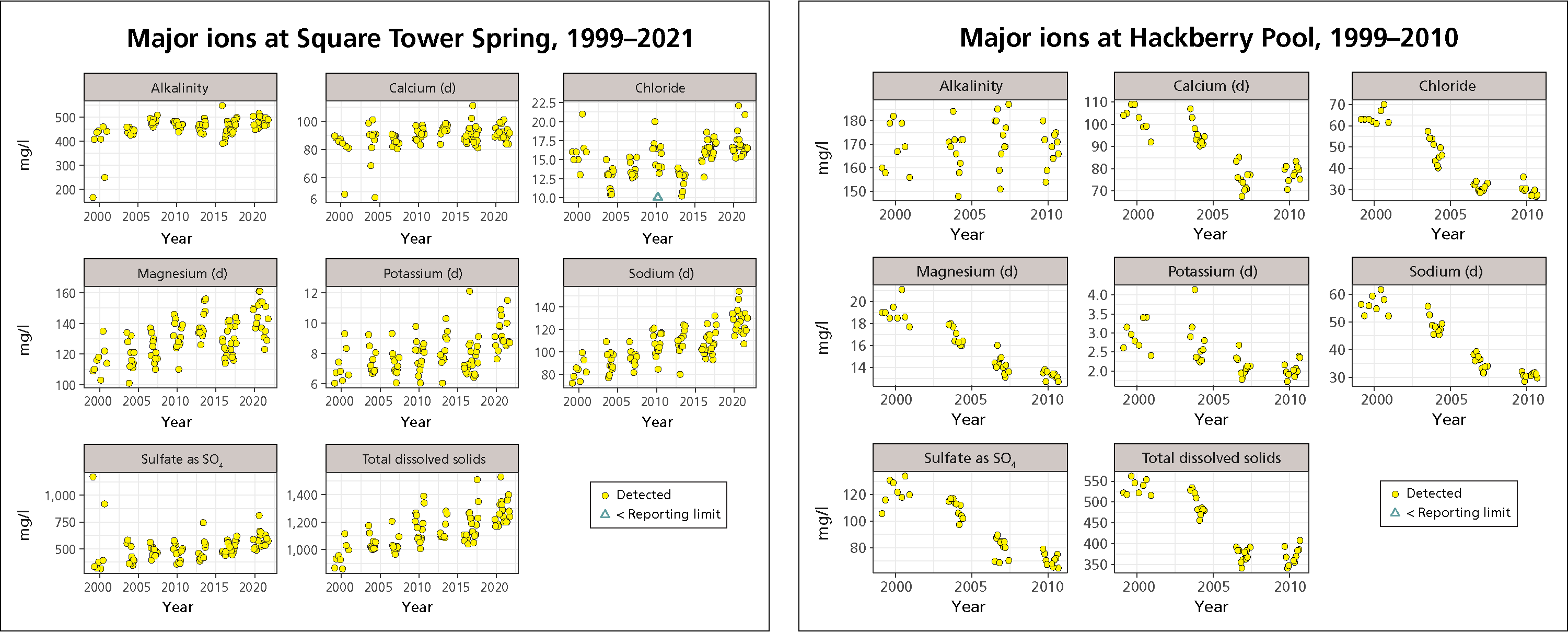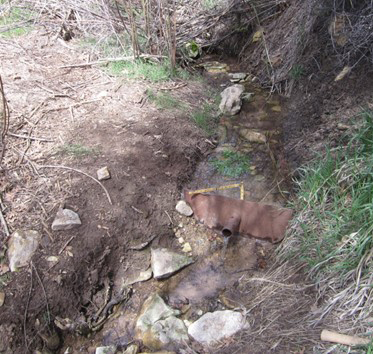Last updated: September 7, 2023
Article
Springs Health at Hovenweep National Monument: Status, Trends, and Recommendations

Square Tower Group, Hovenweep National Monument. NPS/Amy Washuta
Key points
- Springs are naturally and culturally important locations at Hovenweep National Monument.
- Decreasing flow and increasing vegetation stress are likely tied to increasing air temperatures and long-term drought. Studies suggest that prolonged droughts will increase in frequency and duration over the next century or more, due to anthropogenic climate change.
- Square Tower Spring has been the most resilient site at the monument in persistence of surface water and vegetation health during extreme drought.
- Reinstating traditional management techniques could be useful in improving infiltration into aquifers and aquatic-habitat conditions.
Background
Springs are naturally and culturally important locations in the southwestern US. They provide essential water, food resources, and wildlife habitat, and are important oases of biodiversity and productivity in desert landscapes. At Hovenweep National Monument, many of the structures the site was established to preserve are clustered near springs or natural rainwater catchments that serve as the only sources of surface water in the area, making these water resources of significant cultural and natural importance.
During ancestral occupancy, these water resources were actively managed. Indigenous people built check dams and walled springs, basins, and reservoirs to improve access to surface water and potentially augment groundwater recharge.1 Ancestral Puebloans excavated and reinforced both Square Tower Spring and Hackberry Pool, and check dams dot the landscape around Hovenweep NM. Goodman Point Spring is located downstream from an ancestral retention basin. Spring water quality was managed through techniques including clearing debris from springs and cleaning sediment from ponded areas.2
Today, those techniques are no longer actively used at Hovenweep—but water is still a scarce, but vital, resource. The National Park Service has conducted long-term monitoring of monument waters since 1999. A recent report by the Northern Colorado Plateau Network evaluated trends in water quality and quantity over the past two decades at Square Tower Spring, Hackberry Pool, and Goodman Point Spring (see map).

Map of Hovenweep National Monument units. Units discussed in this report are labeled in black font. Units not discussed in this article are labeled in grey.
Water Quality

Square Tower Spring, June 2017.
During each sampling event, water temperature, pH, specific conductance, and dissolved oxygen were measured in the field using a calibrated multiparameter water-quality sonde. Water-chemistry samples were analyzed for major ions, nutrients, and trace elements at the Utah State Public Health Laboratory, using US Environmental Protection Agency (EPA)-approved methods.
From 1999 to 2021, water chemistry in both Square Tower Spring and Hackberry Pool changed significantly, but in opposite directions. Water-quality parameters at Goodman Point Spring remained stable.
Square Tower Spring had increasing total dissolved solids (TDS) and specific conductance, with all major ions showing increases over time. The current water chemistry does not suggest that these increases are related to contamination from oil and gas production, one of the primary concerns when establishing the monitoring program at Hovenweep NM.3 But the cause of these trends is unknown. Follow-up sampling with targeted analytes could provide more information.
In contrast, Hackberry Pool had decreases in TDS and most major ions through 2010 (when logistical constraints caused water-chemistry lab analyses to be suspended at this site). Specific conductance continued to decrease at Hackberry Pool through 2021. The reasons for these changes are unknown, but the decreases in major ions may reflect geomorphic changes that are allowing an increased amount of water entering the pool from rain and snowmelt. After adjusting for pool levels, most of the decreasing trends stabilized, suggesting that pool level was a likely factor. Square Tower Spring, which is isolated from runoff, had a similar increase in pool level—but rather than decreases, there were increases in specific conductance and major ions over time.

At Square Tower Spring, all major ions increased over time. At Hackberry Pool, most of them decreased over time.

Springflow monitoring location at Goodman Point, April 2017.
While the causes of trends in water chemistry at these sites are likely natural, harsh water-quality conditions and small quantities of water (see below) make these sites poor habitat for aquatic life. Groundwater is naturally low in dissolved oxygen—but dissolved-oxygen concentrations in the two pools are persistently low, sometimes falling to near zero in the summer. Water temperatures also warm in conjunction with air temperatures, with temperatures as warm as 18°C in the pools and 19°C in Goodman Point Spring. Traditionally, Puebloan cultures would have managed these small water resources to promote infiltration and retention of precipitation and remove sediment and debris.
Water Quantity
Pool-level measurements were collected by measuring the depth to pool surface from a permanent measuring point and then subtracting that value from an arbitrary datum of 1.5 meters. Flow measurements were collected by channeling flow with a temporary weir and averaging 3–5 timed volumetric measurements.
Flow decreased by more than half at Goodman Point Spring from 1999 to 2021. During the same period, two other springs at Hovenweep NM were removed from the monitoring rotation because flows were increasingly absent or too low to measure. In addition, vegetation showed signs of increased water stress at most sites, and there is evidence of long-term drying at Goodman Point Spring (see photo gallery).
Decreasing flow and increasing vegetation stress are likely tied to increasing air temperatures and long-term drought across the region. The period of record for our monitoring data (1999–2021) corresponds almost exactly to the severest drought recorded in the US Southwest for more than 1,200 years.4 Studies suggest that such prolonged droughts will increase in frequency and duration over the next century or more, due to anthropogenic climate change.5 Despite fluctuations in annual precipitation, water deficit is increasing and drought conditions were common at Hovenweep NM from 2000 to 2019.6 Regionally, the underlying Dakota aquifer that feeds springs at the monument was relatively stable from 2008 to 2017, with decreasing levels from 2018 to 2021. Our data suggest that flowing springs and spring-associated vegetation are vulnerable to drought because of increased evapotranspiration associated with higher air temperatures.

Decreasing flow and increasing vegetation stress are likely tied to increasing air temperatures and long-term drought. Our data suggest that flowing springs and spring-associated vegetation are vulnerable to drought because of increased evapotranspiration associated with higher air temperatures.

Hackberry Pool, June 2017.
The aquifers feeding Square Tower Spring and Hackberry Pool do not yet seem be affected by changes in precipitation or recharge. In fact, surface water at the Square Tower and Hackberry pools has shown great resilience through historic drought. Pool levels at both Square Tower Spring and Hackberry Pool went up during the period of record, although air temperatures above about 20 °C were associated with lower pool levels. Signs of water stress have not yet been noted at Square Tower Spring, which has a small grove of mature hackberry trees. After a robust monsoon season in 2021, hackberry-tree seedlings were noted at both Hackberry Pool and Square Tower Spring. This suggests that if the local Dakota aquifer remains protected from increased withdrawals, these springs may be able to persist through a warming future.
Management Recommendations
Overall, the primary threat to springs at Hovenweep NM is the effects of climate change. Increasing air temperature threatens springflow and spring-associated vegetation. While spring pool levels have increased, recent decreases in the regional Dakota aquifer raise concerns about the stability of pools in the future. Managers could consider the potential benefits of:
- Prioritizing protections and actions at Square Tower Spring, which has been the most resilient site at the monument in persistence of surface water and vegetation health during extreme drought.
- Implementing potential climate-adaptation actions that could improve groundwater infiltration upgradient of spring sites. This could include rehabilitating traditional structures to slow the flow of surface water.
- Investigating and implementing traditional management techniques that could increase dissolved-oxygen concentrations in the spring pools.
- Developing interpretive stories about water-management techniques and the role of climate change in creating drought stress on iconic hackberry trees.
If reinstated, traditional management techniques could be useful in improving infiltration into aquifers and aquatic-habitat conditions. The effects of such techniques have not been scientifically studied, and potential increases in water quantity and dissolved-oxygen concentrations are plausible but not guaranteed. The potential risks of such techniques are also unknown. Continued long-term monitoring associated with these management techniques could help potentially answer some of these questions.
Information in this article was summarized from R. Weissinger, 2023. Status and trends of springs at Hovenweep National Monument, 1999–2021. Natural Resource Report NPS/NCPN/NRR—2023/2560. National Park Service, Fort Collins, Colorado.
Notes
1Crown, P.L. 1987. Water storage in the prehistoric Southwest. Kiva 52(3):209–228; Rohn, A.H. 1972. Social Implications of Pueblo Water Management in the Northern San Juan. Zeitschrift Für Ethnologie 97(2):212–219.
2Rohn 1972; Wilshusen, R.H., M.J. Churchill, and J.M. Potter. 1997. Prehistoric reservoirs and water basins in the Mesa Verde Region: Intensification of water collection strategies during the Great Pueblo Period. American Antiquity 62(4):664–681.
3Schelz, C., and M. Moran. 2006. Water quality monitoring: Hovenweep National Monument 1999–2005. General Technical Report SEUG-001-2006. National Park Service, Southeast Utah Group, Moab, Utah.
4Wahl, E.R., E. Zorita, H.F. Diaz, and A. Hoell. 2022. Southwestern United States drought of the 21st century presages drier conditions into the future. Communications Earth & Environment 3:202. https://doi.org/10.1038/s43247-022-00532-4; Williams, A.P., B.I. Cook, and J.E. Smerdon. 2022. Rapid intensification of the emerging southwestern North American megadrought in 2020–2021. Nature Climate Change 12:232–234. https://doi.org/10.1038/s41558-022-01290-z.
5Cook, B.I., J.S. Mankin, A.P. Williams, K.D. Marvel, J.E. Smerdon, and H. Liu. 2021. Uncertainties, limits, and benefits of climate change mitigation for soil moisture drought in southwestern North America. Earth’s Future 9, e2021EF002014.
6US Drought Monitor (https://droughtmonitor.unl.edu), accessed 6/27/2023.

